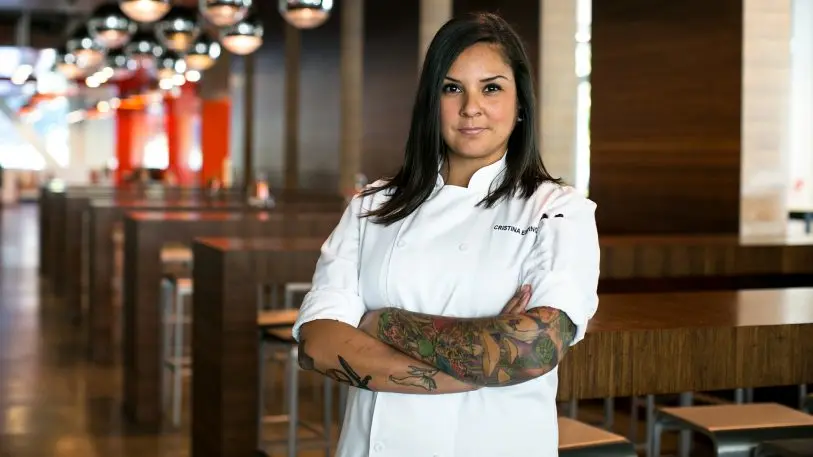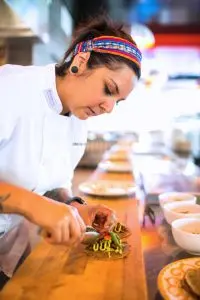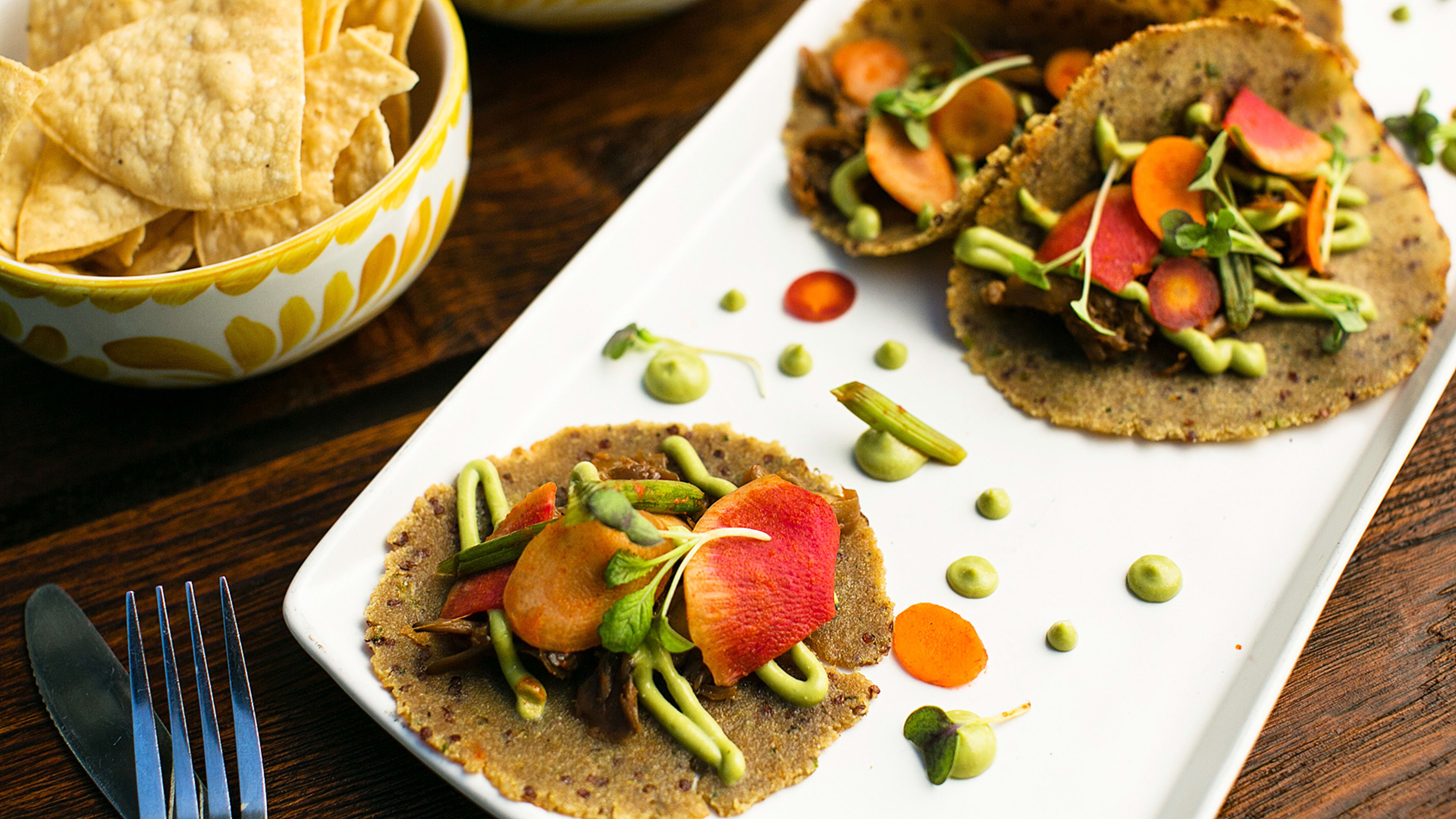If you work at Google’s Sunnyvale campus–like its other offices–lunch presents a multitude of choices. Fourteen separate employee cafes serve everything from pho to braised lamb or grilled trout, all free. But each restaurant also subtly nudges diners to make one choice in particular: eat less meat.
On a Friday afternoon, a cafe called BRGR lists a vegan burger first on its menu for the day; another burger, highlighted in a box in a center of the menu, is a “blended” version that uses mushrooms along with beef in the patty, reducing the total amount of meat. At a Vietnamese cafe, vegetable broth is listed before meat in the options for pho. And in a Mexican cafe, a chef is testing a new recipe for a vegan taco explicitly designed to compete with more popular meat-based dishes.
The nudges fit into Google’s broader sustainability vision. This year, the company will hit its goal of purchasing 100% renewable energy, and it recognizes that meat consumption is also an important part of its carbon footprint. (By one estimate, raising livestock for meat, dairy, and eggs is responsible for 14.5% percentage of global emissions).

One theory: Restaurants need new recipes to compete with so-called “power dishes”–the entrees most commonly found on menus in the United States. Right now, number one is a chicken sandwich, followed by a chicken salad, and salmon. Out of the top 20, only one, a veggie sandwich/wrap, doesn’t have meat. Google, along with a small group of other organizations that are part of the Better Buying Lab, has spent the last six months experimenting with recipes for a new “plant-forward” dish that could make the list.
“We were trying to solve for a delicious alternative that would displace a good proportion of animal protein,” says Scott Giambastiani, Google’s global food program chef and operations manager. “It might be completely vegetarian, or it might be what we call a flipped product, where you’re eating 20% or 30% less of the animal protein.”
The company’s typical strategy is not to try to convert meat-lovers immediately to fully vegetarian food; this is in line with a World Resources Institute study that calculated that if meat-heavy regions cut back on meat 50%, it could reduce their per-person greenhouse gas emissions from agriculture by about half. The blended burger, like a similar burger now served at some locations of the fast-food chain Sonic, is a good example of the reduction strategy. The mushrooms, which soak up the flavor of the beef as they cook and add moisture, make the patty taste better while trimming the carbon footprint. The version served at Google has slowly increased the percentage of mushrooms in the patty from 20% to 50%. (Because beef has the highest carbon footprint of any meat, Google says it is particularly aggressive in its work to reduce the beef each Googler consumes). In other dishes, meat might shift from being the center of the meal to a side or garnish.
“It’s moving people along a continuum, whether people are eating red meat every day and you ask them to start eating a little more white meat, or they’re already on a white meat kick and it’s a little bit more seafood, or moving even further along to alternative proteins or produce. You can’t expect everyone to start loving lentils day one,” Giambastiani says. “Some do, most don’t. What you’re trying to do instead is get people to think about that continuum.”

“Who doesn’t love a good taco?” Giambastiani says. The dish was relatable and familiar, but also unusual enough to be interesting; chef Cristina Espinosa (who works for Bon Appétit, Google’s catering company) took inspiration from her mother’s handmade tortillas to make a new tortilla from quinoa and broccoli, then filled it with kimchi and Korean-spiced sautéed mushrooms, topped with an avocado-cashew cream. Like most things at Google, the process of developing the dish relied partly on data, using feedback from hundreds of Googlers who volunteered for taste tests. “We took a lot of time to get it right,”Giambastiani says.

“We judged the dishes based off of nutritional content and density, greenhouse gas emissions being low, but ultimately it came down to one thing–it came down to flavor,” says Giambastiani. “If the flavor of the dish was something that people loved, we knew that could be something that we could potentially scale outside of the Google walls, and try to make a bigger impact in a quick service restaurant…Success for us would look like the Sonic example [as the first fast food restaurant to serve a blended burger] happening on more and more menus.”
Over the next few months, Google and the other partners are working with researchers from Yale to study how popular the new “power dishes” are and how that shift translates into specific environmental benefits. They’ll also test how menu descriptions can make people more or less likely to choose a particular food.
“People have an expectation when they see the word ‘taco,'” says Giambastiani. “When they look at that title, if it says vegan, I’m running for the hills. I love vegan, but I don’t want to see it on the menu. I want you to deliver an experience in what I’m about to eat and something that’s exciting. So it needs to look good, taste good, and it needs to sound good on the menu.”
In initial taste tests, the taco was called simply a “mushroom taco” to avoid influencing tasters, and then “oyster mushroom taco,” “Korean spiced maitake taco,” and “spicy multi-nut maitake taco and quinoa tortilla.” Though Google is just beginning the process of testing to see how different names influence selection of the taco, previous research from Stanford found that if plant-based dishes are described with “indulgent” language more often used for meat dishes, diners are 25% more likely to choose them compared to when they use “basic” labels (and 35% more than “healthy” labels). Google has also found that diners respond to labels that refer to geography, nostalgia, unique ingredients and cooking techniques, and references to personal stories, such as “Great grandma’s Tuscan stew.”
The tweaks to descriptions on menus, along with rearranging the order of items on menus, are similar to other nudges that Google uses for health, such as offering smaller-size plates, or tiny servings of smoothies near much larger-size water glasses to encourage people to drink less sugar and more water, or focusing on making salad stations as tempting as possible. The company has found that its health nudges help make Googlers 71% more likely to eat healthier at work than outside of it. While a chef might share the health and sustainability benefits of a particular food with someone as the food is served, the cafes don’t have signs with sustainability messages. The object isn’t to guilt people into eating something or not eating something else, but to use behavioral science to make the best choice more likely to happen.
“We need to think through how we can make a better choice easier for people,” Giambastiani says.
Correction: This article originally misspelled chef Espinosa’s name. We regret the error. As well, this article cited a World Resources Institute study that calculated that if meat-heavy regions cut back on meat, they could reduce their emissions by half. They have to cut back meat consumption 50%, not 17% as originally stated.
Recognize your brand’s excellence by applying to this year’s Brands That Matter Awards before the early-rate deadline, May 3.
